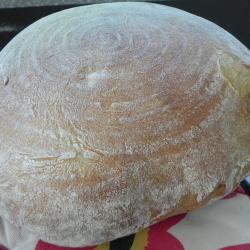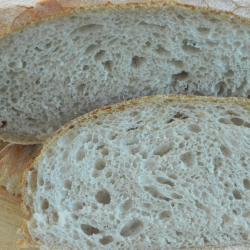Well, i haven't posted on here for AGES, but that doesn't mean I haven't been making bread! The oven is just as busy as ever! however I did buy myself and iPad back in August, and I'm unable to post from this (don't know what the IT problem there is - maybe something to do with flashplayer? Any suggestions Maedi?), so I have to remember to bring my laptop home from work, which I seem to be a bit slack at! So anyway, I have a few loaves to add to my Local Breads blog . . . ..
Starting with this Pane casareccio di Genzano which despite having yeast in it as well as levain I really liked. As I've metnioned with the other Italian breads so far in the book, all of them are either yeasted or hybrids, which does irk me somewhat, but I am perservering as per my quest to make and blog about every bread in the book. This is a MASSIVE loaf, that I decided to make into 2 loaves the second time I cooked it. It has a wonderful dark, thick crust and a very moist crumb. The dough does require a lot of mixing so I used Mr Purple my trusty Kitchen Aid for the hard work. It is also a very wet and sticky dough, which was a challenge to handle and shape.
So here we go:
The biga natural to start is made from 28g f your favourite starter – it says you can use liquid, stiff or rye – along with 140g water and 200g high gluten flour (total weight of starter 368g). Note: this recipe uses all of the starter you make, there is none left over to keep, so you might want to adjust your measurements to make a bit more for next time. Leave the biga to ferment for about 8-12 hours at RT. I was at the stage where I needed to give all of mine a feed, so used a mixture of all 3 to make the bread – 100g stiff white, 130g 100% rye and the remainder my 130% white.
Starter bubbling away and ready to go
The dough: cover all of your biga with 400g tepid water and break it up a bit, then add 500g high gluten flour (I just used AP), ¾ tsp dry yeast, 15g salt (I used 20g salt as always find these recipes a bit under-salted for my taste) and mix till a very wet dough forms. I then put my mixer bowl on the stand of Mr P and gave it a mix at about speed 6 for 10 minutes, and boy did the mixer have a good trot all over the kitchen bench, so for heaven’s sake don’t leave the room! You will need to stop it a few times and scrape the dough off the hook as it does work its way right up to the top. Once this 10mins is up, turn the mixer up to full blast for another 10mins! After about 4mins into the 2nd knead my dough was starting to clear the sides of the bowl. Part way through this 2nd knead Mr P just stopped and I thought he had overheated! But no, he had just given the knife block a bit of a shove into the power point and had turned the switch off!! Phew!
Once I had a lovely window pane, I let the dough ferment at RT for about 1.5hrs, then gave it a fold – it was VERY sticky, but easy enough to handle with oiled hands.
It went back in the bowl at RT for about another 1.5hrs.
Before shaping, coat your large banneton(s) or colander with bran and sprinkle the bench with flour (I shaped the dough into 2 rounds as my round banneton is too small for all this dough). Turn the dough out on to the bench and gently shape into a round as best you can. Because the dough is soft and sticky, handle as little as you can. Put the shaped loaves smooth side down into your banneton/ colander(s), coat with more bran and then put inside a plastic bag and leave to rise for about 1.5hrs.
Once proofed, tip the loaves gently out onto a peel covered in baking paper that has been sprinkled with bran. The loaves were baked at 230C (450F) on my baking stone with steam for 30mins, then turn the oven down to 200C (400F) and bake till quite dark, almost charred looking – 20 or 30mins more.


I have kept very shoddy records of my bread lately, and I'm not entirely convinced those last 2 photos are the Genzano loaf. Colour seems to pale and the crumb not moist enough, but the photo dates seem about right.
Regadless, despite the yeast in the mixture it was a good bread!
K.
Happiness is making bread!

Replies
Wow Karnie,
No wonder Mr P shuffled over and switched himself off - he'd obviously had enough :-)
Nice bread though. And you are right, the photo doesn't quite fit with your description of the appearance except that it looks to have been made with a very slack dough.
Keep up the good work.
Farinam
I just left the yeast out and it was fine. It is warm here around 30+- degrees C and with the yeast it would over ferment, so I left it out. This has not really affected the final loaf.
I haven't figured out how to post pictures on here yet but this is coming from my iPad.